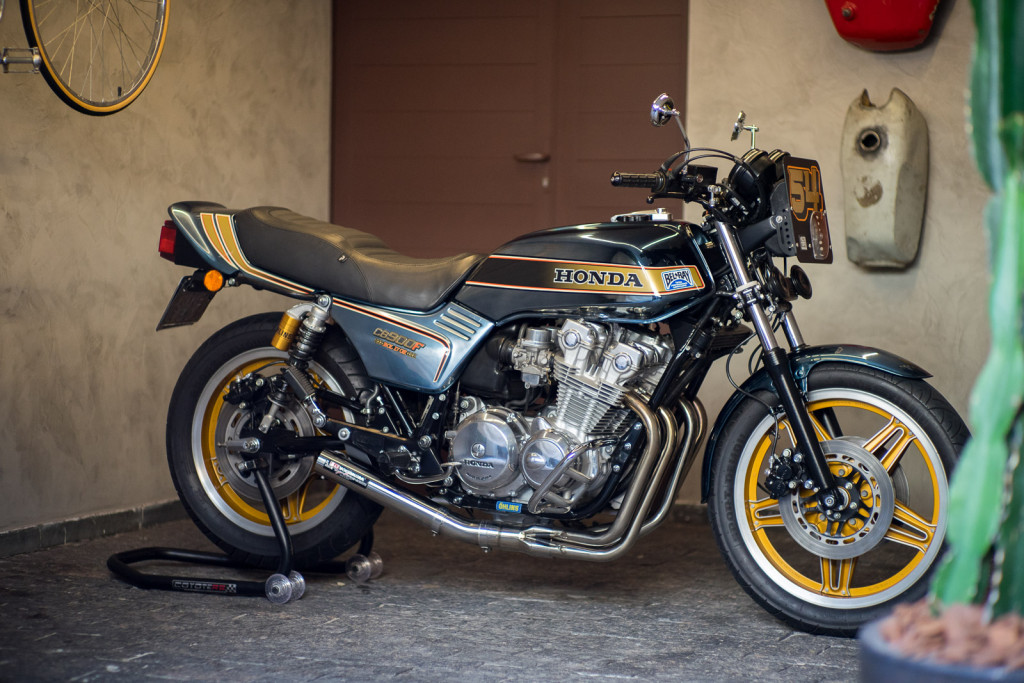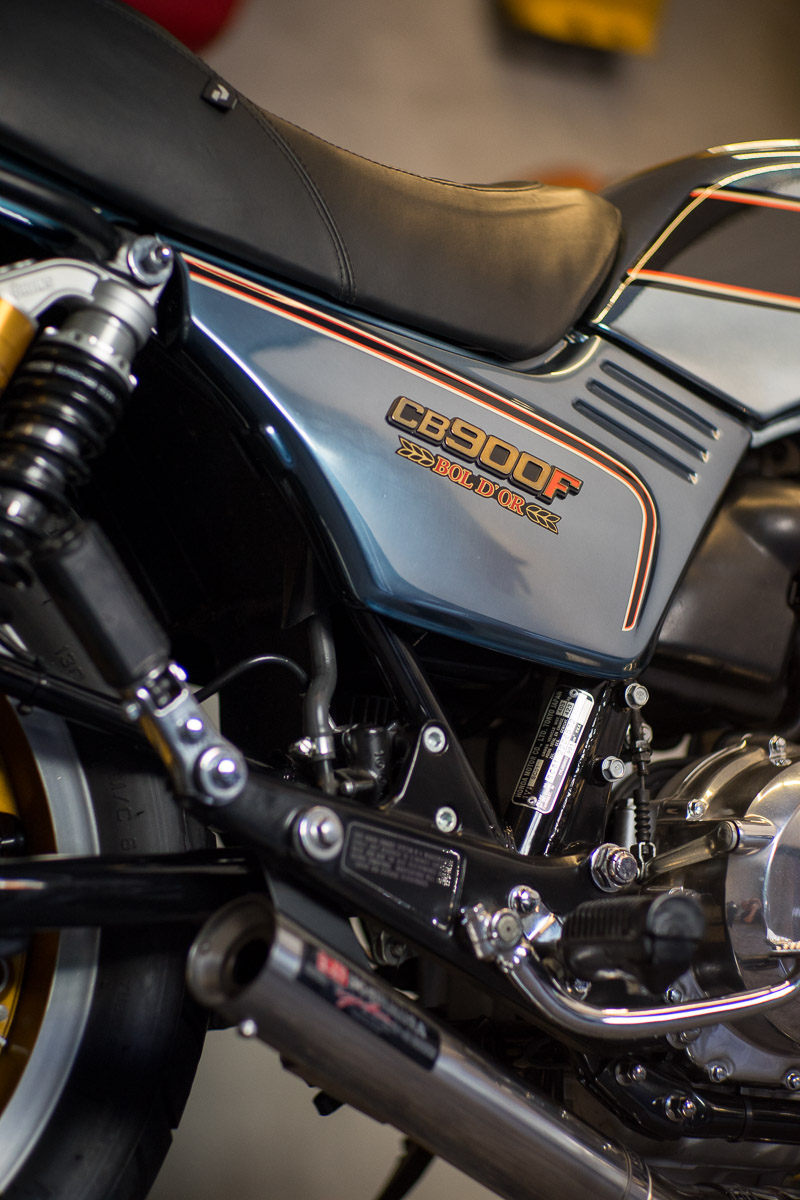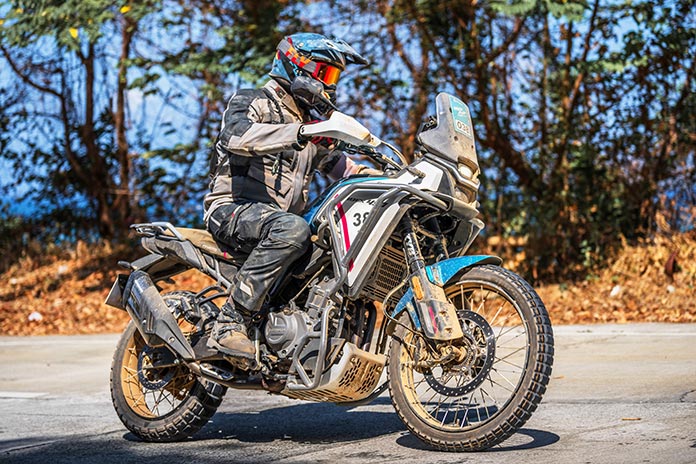A Race-inspired CB900F from Outdated Tops Storage…
In 1979, Honda declared their newly unveiled CB900F to be a “a thundering Tremendous-Sports activities bike with devastating efficiency and an unwavering stamina.” Initially generally known as the CB900F Tremendous Sport, it will renamed the Bol d’Or (Golden Bowl) in honor of the 24-hour French motorbike endurance race of the identical title — a race Honda would win 12 instances between 1975 and 1990.
Designed for the European market, the 901cc, 95-hp inline 4 clocked a quarter-mile time of 11.84 seconds and prime pace of 130 mph, although the engine had been tuned extra for midrange reasonably than peak horsepower.
Although the twin-downtube metal cradle body was a standard design, the CB900F managed to attain excessive marks amongst reviewers for its dealing with, and at least Kevin Cameron of Cycle World all however deified the CB900F in 1985:
“The last word assertion of the outdated air-cooled expertise Honda had accomplished a lot to create”. -Kevin Cameron, Cycle World
Enter our new buddy Fábio Astolpho, a Brazilian artwork director who grew up amongst a household of motorcyclists. Designing customized bikes has allowed him to focus his abilities into one thing with extra endurance than he normally will get to get pleasure from at his day job:
“I needed to apply my expertise and information of artwork route to one thing everlasting, in contrast to the promoting campaigns I do, which have a brief lifespan. I design and plan every part, however I don’t execute. For that, I’ve some rigorously chosen companions who carry my concepts to life.”
After constructing a ’73 CB750 café racer, Fábio took an interest within the DOHC Honda fours of the late 70s and early 80s, particularly the race bikes competing in AMA Superbike and the European Endurance World Championship collection.
“The entire idea got here from the racing bikes of that point, primarily the superbikes that participated within the AMA races, together with Freddie Spencer’s traditional Honda, and the European endurance bikes.”
The bike is now rolling on Öhlins suspension, and the rebuilt engine was fitted with a high-flow consumption, Dyna ignition coils, and a Delkevic 4:1 exhaust. With a view to preserve the racing look, all the lighting could be very minimalist, together with a entrance quantity plate with built-in headlight. The #54 has a particular which means for Fábio:
“In 1954, Honda participated in its first race exterior of Japan. And this race came about on the Interlagos racetrack in São Paulo, Brazil, precisely the place I reside.”
The paint is one other placing side of the construct. It’s the results of metallization, typically generally known as thermal spray coating, whereby metals reminiscent of zinc or aluminum are deposited as a skinny steel movie on prime of the bottom materials.
“It was initially painted in Cadillac black, varnished, and polished. After that, it went for metallization. When it returned, the looks was between polished aluminum and chrome. That’s after we utilized a number of layers of blue-tinted varnish in a lightweight gradient from the entrance to the again.”
Fábio says the top result’s arduous to really admire within the images, however the bike and end draw a lot consideration in individual that he needs to be in temper simply to trip the bike, because it sparks dialog at each cease:
“The true pleasure is in driving a motorbike that could be very uncommon in Brazil and wherever it goes, it brings smiles to those that see it.”
Under, we speak to Fábio for the total particulars on his #54 CB900F Bol d’Or.
Honda CB900F Bol d’Or: Builder Interview
• Please inform us a bit about your self, your historical past with bikes, and your workshop.
I’m an promoting skilled, and my predominant job has all the time been artwork route. My involvement with bikes goes again to my childhood, as my father had a few bikes and so did a few of my cousins (in reality, it was with considered one of them that I discovered how you can trip). I’ve all the time favored classic bikes with traditional designs, in all probability as a result of I grew up round them.
After I constructed my first custom-made motorbike (a 1973 CB 750K), I understood the chance that I needed to apply my expertise and information of artwork route to one thing everlasting, in contrast to the promoting campaigns I do, which have a brief lifespan. I design and plan every part, however I don’t execute. For that, I’ve some rigorously chosen companions who carry my concepts to life.
• What’s the make, mannequin, and yr of the donor bike?
It’s a Honda CB900F Bol d’Or (Tremendous Sport within the U.S.) 1981.
• Why was this bike constructed?
After constructing a 1973 CB750 café racer, I turned extra interested by Honda 4-cylinder bikes that had been a bit of newer, on the flip of the Seventies to the Nineteen Eighties. Nevertheless, this time I needed a undertaking that might stand out with out even having a chopped body or any radical and irreversible alterations.
• What was the design idea and what influenced the construct?
The entire idea got here from the racing bikes of that point, primarily the superbikes that participated within the AMA races, together with Freddie Spencer’s traditional Honda, and the European endurance bikes.
• What customized work was accomplished to the bike?
The motorbike was utterly dismantled to start the work, and the most important upgrades had been made to the suspension, electrical system, and consumption and exhaust system. Like in my first undertaking, I didn’t desire a motorbike that regarded prefer it had been modernized. This made me preserve the unique visuals, however with hidden upgrades, more often than not.
The suspension obtained new Öhlins springs within the entrance and Öhlins shocks within the rear. The consumption obtained a sports activities air filter and a 4-into-1 exhaust (a Delkevic one), and {the electrical} system obtained new Dyna coils. The engine was utterly overhauled and runs like a appeal.
When it comes to aesthetics, that’s the place I labored to realize a consequence that paid homage to the unique, however with the flashy aesthetics of the late Seventies and with out the excesses that began appearing within the Nineteen Eighties.
Due to this fact, the very first thing to be accomplished was to get rid of the large unique flip alerts and make the bike lighter. In the present day the motorbike has, within the rear, an built-in taillight, brake mild, and switch alerts. And within the entrance, extraordinarily discreet flip alerts built-in into the forks. As well as, to finish the racing look, a quantity plate on the entrance with an built-in headlight and a enormously diminished rear fender. The seat was barely redesigned, bringing the identical spirit as the remainder of the design.
Nevertheless, the spotlight of the motorbike is basically the paint. The motorbike was not truly painted: it underwent a vacuum metallization course of. To realize this consequence, it was initially painted in Cadillac black, varnished, and polished. After that, it went for metallization. When it returned, the looks was between polished aluminum and chrome. That’s after we utilized a number of layers of blue-tinted varnish in a lightweight gradient from the entrance to the again.
When the paint was prepared, a buddy informed me, “Prepare. This bike will entice a lot consideration which you can solely trip it for those who’re in temper. As a result of, in any case, everybody will come to speak to you concerning the motorbike.” He was proper. The images don’t replicate the way it shines and its end attracts consideration. Precisely what I imagined.
• Does the bike have a nickname?
Its nickname is the quantity on the quantity plate: 54. The reason being that in 1954, Honda participated in its first race exterior of Japan. And this race came about on the Interlagos racetrack in São Paulo, Brazil, precisely the place I reside.
• Any thought of horsepower, weight, and/or efficiency numbers?
Contemplating that the unique bike has 95 horsepower and weighed 240kg, I consider that at this time it’s a bike with a bit of over 105 horsepower and has misplaced round 20kg in its closing weight.
• Are you able to inform us what it’s prefer to trip this bike?
This can be a motorbike that was initially pleasant to trip, however the customizations have made it rather more highly effective and responsive for cornering. Undoubtedly, the most important distinction is within the suspension. However the true pleasure is in driving a motorbike that could be very uncommon in Brazil and wherever it goes, it brings smiles to those that see it.
• Was there something accomplished throughout this construct that you’re significantly happy with?
Positively the aesthetic half is what I’m most happy with: the results of the metallization course of and the varnish with the modifications that gave it a racer look actually reworked the bike.
• Is there anybody you’d prefer to thank?
Certain! I design and plan every part, however I’ve some individuals working with me who execute, every one caring for a particular a part of what the bike has develop into at this time. @zmotorcyclesbr took care of all of the mechanical work and meeting. @alemaospecialpaint delivered to life the paint scheme that was in my thoughts. And my buddy Fred from @atlanticcustomstudio, who constructed just a few, however essential components, to make the bike look the way in which it does at this time.
Comply with the Builder
Instagram: @oldtopsgarage
Images: @fabioastolpho
The post Honda CB900F Bol d’Or Superbike – BikeBound appeared first on lickscycles.com.
source https://lickscycles.com/honda-cb900f-bol-dor-superbike-bikebound/?utm_source=rss&utm_medium=rss&utm_campaign=honda-cb900f-bol-dor-superbike-bikebound


















No comments:
Post a Comment